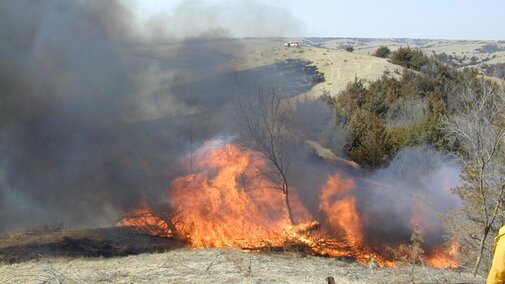Prescribed Burning for Control of Cedar Trees
Eastern red cedar trees are a significant and expanding problem across many pasture and rangeland acres in Nebraska. When fire is planned and controlled properly, it can be a very useful tool to control these unwanted plants.
It is estimated that a single cedar tree with an 8-foot diameter could reduce forage production by three pounds. If you had a density of 200 trees per acre, that would translate into nearly a third loss in forage production because of the effects of area coverage, moisture use and shading.
In addition to cedar tree impacts on forage production, excessive cedar trees will also dramatically alter habitat for many wildlife species that are adapted to a grassland environment. While mechanical cutting or shredding and herbicides are options to control cedar trees, a prescribed burn is by far the most economical approach.
Safe and controlled prescribed burns don’t just happen. It takes preparation, planning and an understanding of how fire reacts in certain weather conditions, with particular fuel loads, and on various types of topography.
You can begin to learn how to conduct a safe, legal and effective prescribed burn by attending one of several prescribed fire training workshops held during January and February. Pheasants Forever, the Nebraska Game and Parks Commission and other conservation partners sponsor the workshops that will be held at various locations across Nebraska.
To see a list of locations and dates, search on the internet for “Nebraska Prescribed Fire Workshops”.
Net Wrap and Twine
By Brad Schick
Net wrap and twine are issues every livestock producer must address at least some point in the year. Cattle that consume too much can develop health problems.
With producers feeding more hay this year than usual, there is even more labor feeding and potential concerns about net wrap. If animals do eat the wrap, it can accumulate in the rumen, causing obstructions.
North Dakota State University performed research showing that net wrap and even biodegradable twine were not digested by the microbes in the rumen. Steers fed ground hay without the net wrap removed before grinding were monitored in the study. A full two weeks before steers were harvested, they were given feed with all the net wrap removed, and the net wrap fed earlier was still present throughout the rumen at harvest.
What does this mean for our daily operations? Steers or heifers going to harvest are less of a concern due to their lack of time fed the net wrap. Brood cows, however, are more of a concern if we want cows on the operation healthy for years. Although the health concern is very low, grinding net-wrapped hay or removing the net wrap if rolled out or busted, is recommended to reduce the chance of our cows having any issues.
A little time can eliminate a big headache and each operation needs to evaluate the risks associated with the decision to remove net wrap and twine.

